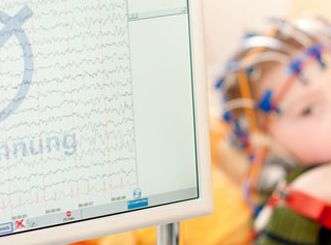Disease gene discovered for frequent epilepsy in childhood

More than 50 million people worldwide have epilepsy, with a third of these being children. The most common forms of epilepsy in children occur without any apparent trigger and only affect certain regions of the brain. This condition is known as idiopathic focal epilepsy (IFE). The hallmark of IFE is the origin of the fit being in what is termed the rolandic region of the brain. Now, thanks to the considerable input of MedUni Vienna researchers, two pan-European research networks have successfully identified the first disease gene for IFE.
The gene concerned is known as GRIN2A. Changes to this gene cause one of the key ion channels in the brain to malfunction, affecting the electrical excitation of nerve cells. This explains the increased number of electrical discharges in the brain and therefore the manifestation of epileptic fits. The results of the study, which were obtained through the two research networks EuroEPINOMICS and IonNeurOnet, have now been published in the highly respected journal Nature Genetics.
The research project came into being from collaboration between numerous groups of researchers in Europe who shared a common goal: to understand the genetic causes of this type of childhood epilepsy. "What was crucial for our breakthrough was the close cooperation of doctors carrying out clinical research with theoretical researchers," explains Fritz Zimprich from the University Department of Neurology at the MedUni Vienna, who coordinated the researchers involved in the project from Vienna, Graz and Innsbruck. "A third of the patients investigated with state-of-the-art genetic methods come from Austria.
All in all, genetic material from 400 patients with IFE was analysed. In 7.5 per cent of sufferers, the scientists found changes in the GRIN2A gene. In "rolandic epilepsy", which accounts for 15 per cent of cases of childhood epilepsy and therefore makes it the most common form of the condition, these mutations disrupt the function of the NMDA receptor, one of the brain's key ion channels. The flow of ions in this type of channel influences and determines the nerve cells' electrical excitation.
It is however still not yet fully understood how the mutation in the gene on the NMDA receptor leads to epilepsy. Says Zimprich: "We only see the condition as a result of the mutations; we haven't yet fully discovered the mechanisms behind it." The next target is to understand these mechanisms. This is also an essential step in the development of more effective and more tolerable anticonvulsant medications.
More information: Lemke, J. et al. Mutations in GRIN2A cause idiopathic focal epilepsy with rolandic spikes, Nature Genetics, July 18 2013. DOI: 10.1038/ng.2728

















